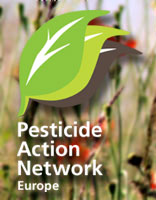5th June 2012
Brussels
Disrupting food: up to 30 different endocrine disrupting pesticides found in fruits and vegetables in the European Union
Lettuce, tomatoes, cucumbers and apples are the food items with on average the highest dose of endocrine disrupting pesticide residues. European consumers will potentially be exposed to up to 30 different pesticide residues with a risk of adverse health effects. This is the outcome of an analysis made by PAN-Europe based on the monitoring data of Food Authority EFSA.
Harmful chemicals. Endocrine disrupting chemicals (EDCs) are active substances which alter the hormonal system of the human body. A large body of scientific evidence has linked EDCs to chronic diseases, such as decreased fertility, hormone-related cancers (breast cancer and prostate cancer), brain damage, obesitas, diabetes [1] . Worryingly, these diseases are on the rise all over Europe. While some progress has been made regarding removing endocrine disruptors from cosmetics, baby bottles or toys, the dangers of EDCs in food items remain surpri singly disregarded.
Alarming results. Residues from up to 30 different ED pesticides were found in the everyday food of European consumers. In several food items such as peppers, more than 20 different ED pesticides were analysed in European countries, leading in the long-term to even more dangerous mixtures – the „cocktail” effects [2]. Lettuces showed to have the highest level of EDCs, closely followed by tomatoes, cucumbers, apples and leeks.
Consumers’ tips. PAN Europe starts today an information campaign on the web : www.disruptingfood.info. Consumers are advised to choose for organic products if possible, especially for the vulnerable like children; and to substitute the high risk food items like lettuce, tomaties and cucumbers in the first place. A „consumer guide” published by PAN Europe gives out very simple and practical tips for the everyday life.
The next step. One major loophole in current pesticides regulation is the absence of specific criteria to officially define EDC. Regulators up to now were slow in adopting new scientific insights such as the effects of low doses [3]. The Commission must come up in December 2013 to repair this. In the meantime, PAN Europe will launch new campaign actions next summer involving European consumers.
— ENDS —
Notes for journalists
[1] See state-of-the-art report by Prof. Kortenkamp, appointed by the European Union : « State-of-the-art assessment fo endocrine disruptors », 2012.
[2] Statement of the Endocrine Society (Endocrine reviews, June 2009), supported in 2011 (Science 331:1136) by 8 other societies representing 40.000 scientists.
[3] For studies on EDCs low dose effects, see : Vandenberg/Soto/Heindel/VomSaal ao. (Endocrine Reviews, June 2012)
Further information
For further information please contact:
Isabelle PINZAUTI. Email : isabelle@pan-europe.info. Tel : + 32 (0)497 695 842
Lucie DANIEL. Email : lucie@pan-europe.info Tel : +32 (0)498 398 1
< Back


